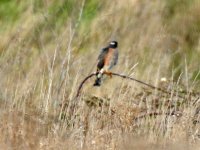This is my penny.
Sparrowhawks have two plumages,
juvenile, until the bird starts moulting in May/June in its second calendar year when approximately one year old, and
adult after the completion of this first total moult, usually finished by September/October.
Although some individuals, mostly females, do show very subtle differences from first adult plumage to later ones (in the former plumage they tend to show some narrow, paler edges on the smallest of the wing coverts, which is not usually the case in subsequent adult plumages) these do not include the white bases of a group of nape feathers, which is something ALL Sparrowhawks sport irrespective of age.
However, it's a fact that juveniles (to a variable degree) have far more extensive white on their napes than adults, in sync with the much more speckled and "untidy" head markings of this first plumage, with streaked, rather than uniform crown and ear coverts, and a far more pronounced whitish supercilium.
Contrary to this, the white on the nape of adult Sparrowhawks is (most often) restricted to the BASAL parts of the individual feather (particularly so in males, which on average also have a weaker, often non-existent whitish supercilium than females), so that it's ONLY when the feathers are RAISED (when the bird is totally relaxed and 'fluffed up' as the bird in the OP) that this white patch becomes visible.
This white flecked nape is believed to create a sort of "fake face" which comes in handy, in that it probably to some extent prevents attacks from predators that perceive the prey as FACING them, and that the prey consequently is fully alert and ready to dash off at any instant.
I'm not saying that intensive measurements of many thousands of skins couldn't possibly produce a very slight difference between first adults and older adults with respect to the widths of the white, basal parts of the nape feathers in question, but the logical response to such a claim would be:
How do you recognise first time adults from older adults in skin collections where only a microscopic fraction would be ringed birds, taking into account that many/most adult birds are impossible to place in a definite first-adult-plumage-bracket because the vague differences (as mentioned above) aren't a constant, particularly in males.
Furthermore Sparrowhawks are very 'orderly' in the sense that they tend to moult COMPLETELY (as opposed to, say, Goshawks) so that in by far the most instances, tell tale, unmoulted, juvenile feathers would be rare to find after October.
In sum, the variation of the extent of white on the (feather bases) of adult A. nisus makes it highly unlikely that this could ever be used to distinguish between first- and older adults both in the hand, in the field, or when viewing a blurred long distance photo of an individual first- or older adult Sparrowhawk with fluffed up nape.
PS I've now seen the photographic ringers guide to sexing/ageing Sparrowhawks in another recent thread here. Although generally instructive and easy to understand, my caveat is that individual variation renders some of the points less useful. One may, for example, quite often see juveniles which fall well outside their respective sex category regarding the type of markings/barring/spots on the underside of both body and wings. Furthermore there's no mention of the (uncommon) extremely dark ("dusky type") of juveniles (most often males), and the (quite common) very adult male like adult females such as this one:
http://www.netfugl.dk/pictures.php?id=showpicture&picture_id=15849
Peter






